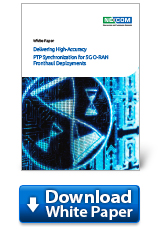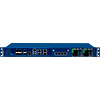Delivering High-Accuracy PTP Synchronization for 5G O-RAN Fronthaul Deployments
The Trend
The recent emergence of 5G accelerated fronthaul deployments is driven by the necessity to enhance mobile broadband (eMBB), the need for ultra-reliable low-latency communications (uRLLC), and massive machine-type communication (mMTC) for Internet of Things (IoT) networks. Such an approach allows new deployment models to move away from closed proprietary network infrastructure, opening up possibilities to enhance network performance, increase flexibility and operating efficiency.
The heyday of 5G Open RAN infrastructure is yet to come, communication service providers (CommSPs) are moving away from hardware-centric solutions toward commercial-off-the-shelf (COTS) appliances and software, at least on a small trial scale. Augmented by the implementation of network functions virtualization (NFV), adoption of SASE and SD-WAN infrastructure, such a decentralized approach gives the flexibility to scale up and out or update services at a faster pace than traditional hardware while reducing the number of edge devices on a customer's premise and costs associated with deployment and maintenance.
Edge devices on-premises, like the other elements within the network infrastructure, must conform to next-generation network standards, especially in terms of bandwidth and latency. Unlike traditional network architecture, 5G O-RAN networks are more complicated, and fronthaul baseband functions are separated into two components, a Distributed Unit (DU) and Central Unit (CU). These appliances within the network must ‘sing together’ to play out a great symphony under perfect orchestration.

The Challenge
To enjoy all advantages of open architecture and 5G networks some actions are required. Among the challenges facing the development of O-RAN networks are their immaturity in technology & infrastructure, cost, limited operational readiness, and a shortage of expertise in the field. However, undeniable advantages and opportunities brought along by 5G networks make enterprises even more determined to overcome these challenges.
O-RAN maintains network timing distribution as the preferred approach within the fronthaul network. Therefore, time and frequency synchronization must be distributed to O-DU and O-RU for effective O-RAN network operation.
For telecommunications networks to operate correctly, reliable and precise synchronization has always been a basic requirement. Thus, to increase efficiency and fulfill challenging 5G use cases, synchronization in the RAN is essential and has been thriving following new radio technologies and network architectures. While the fundamental synchronization requirements in 5G have not been raised, there is a significant boost in demand for time synchronization.
The loose sync can cause a serious negative impact on network KPIs e.g. low throughput, poor attach success rate, and poor handover success rate. To avoid these from happening and protect businesses, CommSPs will have to make sure that the equipment they chose has already been tested to meet industry standards.
NEXCOM Solution
To offer a validated solution and cope with the challenge, NEXCOM introduces its FTA 5180, a high-performance server from the nexCPE™ product line for 5G fronthaul applications. Tests were run together with Intel, with results in conformity with industry requirements. FTA 5180 features BMC and out-of-band (OOB) remote management, simultaneously supporting 5G (sub-6 GHz) and Wi-Fi 6 modules installations, providing seamless connections with a variety of devices.
FTA 5180 is a 1U rackmount in a short form factor, powered by Intel® Xeon® D-1700 processor. It is capable of executing virtualized network functions (VNFs) such as virtual firewalls, SD-WAN, virtual WAN, virtual application delivery controllers, and optimization appliances, making it a jack-of-all-trades appliance for service providers and enterprise customers.
FTA 5180 leverages the power of the eight-core Intel® Xeon® D-1734NT processor with embedded Intel® QuickAssist Technology (Intel® QAT) to provide impeccable performance, while enabling 10 high-bandwidth interfaces for speedy connections, including six 10GbE fiber (SFP+), two 10GbE, and two 2.5GbE copper (RJ45) ports, with one LAN module expansion slot. All four copper ports provide PoE++ support to provide power to powered devices via Ethernet cables for places with a limited quantity of power outlets.
To present FTA 5180’s adaptability for 5G DU/CU, multiple tests were conducted at Intel 5G Innovation Center in Taipei. Test configuration and all of the settings are collected in Table I.
TABLE I
BENCHMARK BY PASSMARK PERFORMANCE TEST 10.1
Items |
Description |
System |
FTA 5180 |
CPU |
Intel® Xeon® D-1734NT |
Memory |
2 x 32 GB |
Storage |
128 GB |
PCIe NIC card |
4 x 10 Gbps x E823 SFP |
Acceleration Card |
Intel® vRAN Accelerator ACC100 Adapter |
OS |
CentOS7.9 |
BIOS |
G518-005 |
Test topology is shown in Figure 1. Data is received through the antenna and forwarded to Open RU. It also collects precise time from GPS satellites and transmits it further to ODU (NEXCOM FTA 5180).
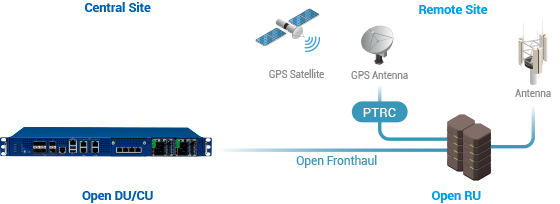
Figure 1. Test Topology
For measuring FTA 5180 fixed wire bandwidth performance full duplex Sub6 tests [u = 1 (30khz) and 100Mhz] with RU Emulator and PTP time sync was conducted. The 5G downlink performance of FTA 5180 reached 1.51Gb/s which is higher than the threshold value required by Intel. Test results are shown in Figure 2.
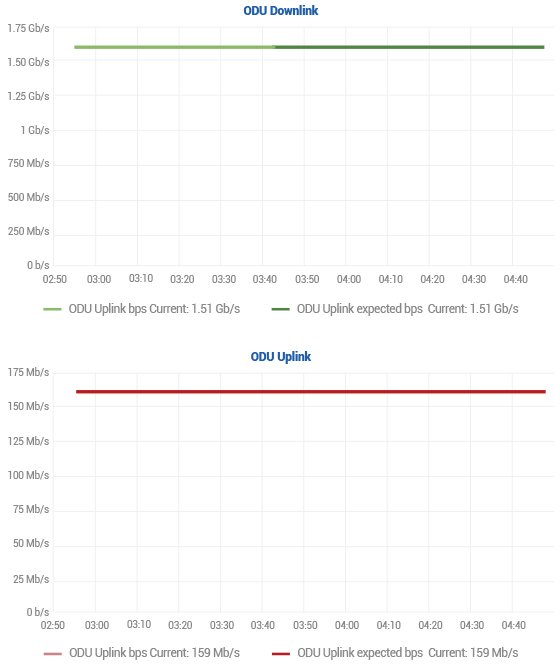
Figure 2. FTA 5180 Fixed Wire Bandwidth Up and Downlink Performance Results
To ensure compliance with PTP standards, ODU PTP Clock offset while the system was running 5G O-DU loading was conducted. The IEEE 1588 PTP (Precision Time Protocol) clock offset requirements to pass the test were less than 100ns between the PHC (PTP Hardware Clock server) and DUT (FTA 5180). The result reveals that the measurement average is significantly better - 29.3ns; the PTP performance of FTA 5180 is very precise and the system clock is synchronized. The results are shown in Figure 3.
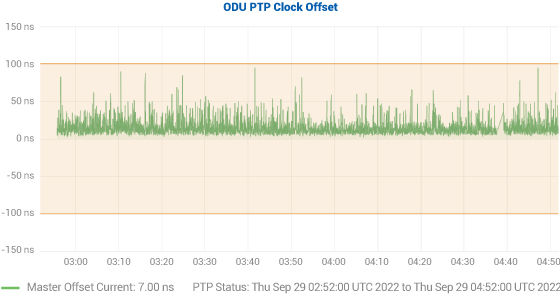
Figure 3. FTA 5180 ODU PTP Clock Offset Test Results
Conclusion
NEXCOM FTA 5180, based on O-RAN alliance specification, is designed to be the next-generation network equipment. It delivers excellent performance per watt, PoE++ functionality, and offers optional support of FWA connectivity, including Wi-Fi 6 and 5G. This allows IT professionals to deploy the boxes across diverse application scenarios and use cases, including 5G public and private networks
Through the long-awaited 5G fronthaul enablement and tests, FTA 5180 shows outstanding results, proving its capability for perfect deployments as DU/CU. The reading significantly surpassed threshold limits, demonstrating once again FTA 5180 is a strong candidate to bring high throughput and improved network efficiency to existing network infrastructure.
|
|---|
- Related Links:
- Achieve Faster AI Insights with NEXCOM FTA 5190 and Xeon® 6 SoC
- NEXCOM Drives Edge AI, Dual 5G, and OT Security Innovation at CommunicAsia 2025
- Browse Other News:
- Urban PET Recycling Reinvented Sustainable Solutions Powered by NDiS B561
- AIEdge-X®80 Leaps Ahead: Power Up TOPS Performance with NVIDIA® Jetson™ Super Mode
- All White Papers News

